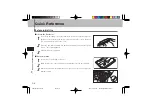
122
PSR-A2000 Owner’s Manual
Styles – Pla
ying Rh
ythm and Accompaniment –
2
9
Start recording by pressing the STYLE CONTROL [START/STOP] button.
Playback of the specified section starts. Since the accompaniment pattern plays back repeatedly in a loop,
you can record individual sounds one by one, listening to the previous sounds as they play. For
information on recording to channels other than the rhythm channels (RHY1, 2), refer to the section
“Rules when recording non-rhythm channels” below.
NOTE
You can turn off the desired channels by pressing the corresponding [1
▼
]–[8
▼
] buttons.
10
To continue recording with another channel, repeat steps 6 –9.
11
Stop recording by pressing the STYLE CONTROL [START/STOP] button.
12
Press the [EXIT] button to close the RECORD display.
13
Press the [I] (SAVE) button to execute the Save operation.
NOTICE
The edited Style will be lost if you change to another Style or turn the power to the instrument off without executing the Save operation.
Deleting recorded notes in the rhythm channel
When you are recording the rhythm channel (RHY1 or RHY2), you can delete a specific instrument
sound by simultaneously holding down the [E] (RHY CLEAR) button and pressing the appropriate key
on the keyboard.
Rules when recording non-rhythm channels
• Use only the CM7 scale tones when recording the BASS and PHRASE channels (i.e., C, D, E, G, A,
and B).
• Use only the chord tones when recording the CHORD and PAD channels (i.e., C, E, G, and B).
Using the data recorded here, the auto accompaniment (Style playback) is appropriately converted
depending on the chord changes you make during your performance. The chord which forms the basis for
this note conversion is called the Source Chord, and is set by default to CM7 (as in the example
illustration above).
You can change the Source Chord (its root and type) from the PARAMETER display on page 128. Keep
in mind that when you change the Source Chord from the default CM7 to another chord, the chord notes
and recommended notes will also change. For details on chord notes and recommended notes, see
page 129.
NOTE
For the INTRO and ENDING sections, any appropriate chord or chord progression can be used.
C R C
C R C
C = Chord note
C, R = Recommended note
Summary of Contents for PSR-A2000 Oriental
Page 203: ...PSR A2000 Owner s Manual 203 ...
















































